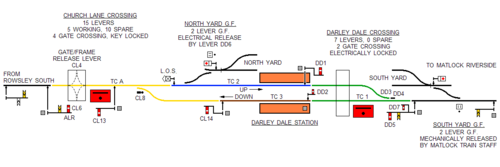| Peak Rail | |
|---|---|
 | |
| Commercial operations | |
| Original gauge | 4 ft 8+1⁄2 in (1,435 mm) standard gauge |
| Preserved operations | |
| Operated by | Peak Rail |
| Stations | 4 |
| Length | 4.3 miles (6.9 km) |
| Preserved gauge | 4 ft 8+1⁄2 in (1,435 mm) |
| Commercial history | |
| Opened | 1863 |
| Closed | 1968 |
| Preservation history | |
| 1987 | Acquires Darley Dale and track relay work begins |
| 1991 | Light Railway Order granted |
| 1992 | Re-opened |
| 1997 | Extended to Rowsley South |
| 2 July 2011 | Extended to Matlock |
| Headquarters | Rowsley South Railway Station |
Peak Rail is a heritage railway in Derbyshire, England, which operates a steam and heritage diesel service for tourists and visitors to both the Peak District and the Derbyshire Dales.
Contents
- History
- First preservation attempts with the Buxton Steam Centre
- Closure of the Buxton Steam Centre and relocation to Darley Dale
- Extension to Matlock (Network Rail) station
- Future developments
- Expansion towards Bakewell
- Monsal Trail
- Signalling on the railway
- Two train running
- Darley Dale footbridge
- Operating groups at the railway
- Motive power
- Steam locomotives
- Diesel locomotives
- Diesel Multiple Units
- Former residents
- Steam
- Diesel
- See also
- References
- External links
The heritage railway line is over 3+1⁄2 miles (5.6 km) in length and, as of April 2016 [update] , operates train services from Matlock station (shared with Derwent Valley Line services from Derby via Ambergate) via the site of Matlock Riverside and Darley Dale to Rowsley South.
Peak Rail intends to extend its operational services northward to Bakewell when resources allow, extending to a total of 4+1⁄4 miles (6.8 km). Beyond Bakewell, the railway trackbed is used by the Monsal Trail.








